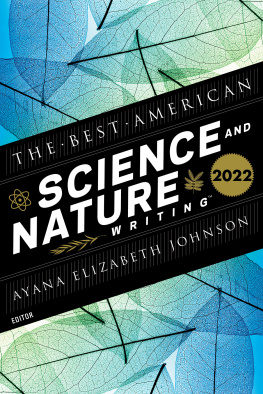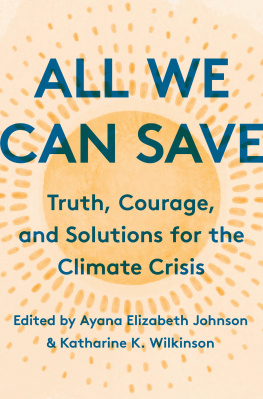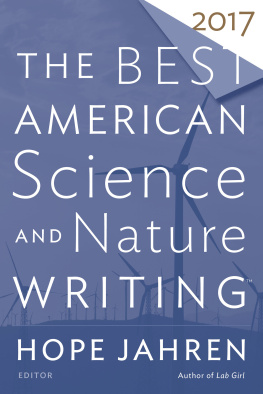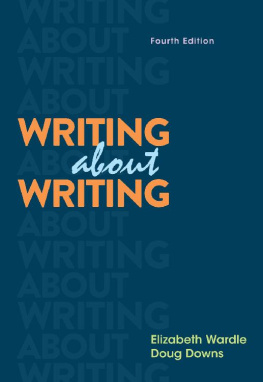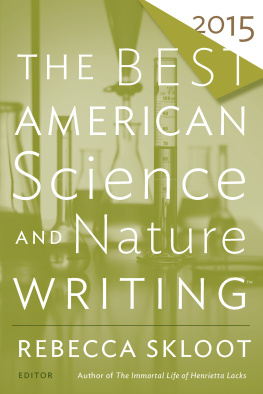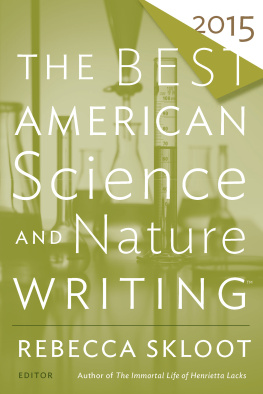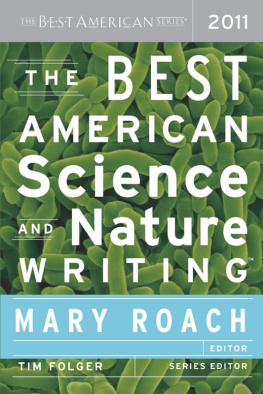Ayana Elizabeth Johnson - The Best American Science And Nature Writing 2022
Here you can read online Ayana Elizabeth Johnson - The Best American Science And Nature Writing 2022 full text of the book (entire story) in english for free. Download pdf and epub, get meaning, cover and reviews about this ebook. year: 2022, publisher: HarperCollins, genre: Romance novel. Description of the work, (preface) as well as reviews are available. Best literature library LitArk.com created for fans of good reading and offers a wide selection of genres:
Romance novel
Science fiction
Adventure
Detective
Science
History
Home and family
Prose
Art
Politics
Computer
Non-fiction
Religion
Business
Children
Humor
Choose a favorite category and find really read worthwhile books. Enjoy immersion in the world of imagination, feel the emotions of the characters or learn something new for yourself, make an fascinating discovery.
- Book:The Best American Science And Nature Writing 2022
- Author:
- Publisher:HarperCollins
- Genre:
- Year:2022
- Rating:3 / 5
- Favourites:Add to favourites
- Your mark:
- 60
- 1
- 2
- 3
- 4
- 5
The Best American Science And Nature Writing 2022: summary, description and annotation
We offer to read an annotation, description, summary or preface (depends on what the author of the book "The Best American Science And Nature Writing 2022" wrote himself). If you haven't found the necessary information about the book — write in the comments, we will try to find it.
The Best American Science And Nature Writing 2022 — read online for free the complete book (whole text) full work
Below is the text of the book, divided by pages. System saving the place of the last page read, allows you to conveniently read the book "The Best American Science And Nature Writing 2022" online for free, without having to search again every time where you left off. Put a bookmark, and you can go to the page where you finished reading at any time.
Font size:
Interval:
Bookmark:

From ProPublica/MIT Technology Review
Along the coast of Northern California near the Oregon border, the cool, moist air off the Pacific sustains a strip of temperate rainforests. Soaring redwoods and Douglas firs dominate these thick, wet woodlands, creating a canopy hundreds of feet high.
But if you travel inland the mix of trees gradually shifts.
Beyond the crest of the Klamath Mountains, you descend into an evergreen medley of sugar pines, incense cedars, and still more Douglas firs. As you continue into the Cascade Range, you pass through sparser forests dominated by Ponderosa pines. These tall, slender trees with prickly cones thrive in the hotter, drier conditions on the eastern side of the state.
All trees consume carbon dioxide, releasing the oxygen and storing the carbon in their trunks, branches, and roots. Every ton of carbon sequestered in a living tree is a ton that isnt contributing to climate change. And that thick coastal forest can easily store twice as much carbon per acre as the trees deeper inland.
This math is crucial to determining the success of Californias forest offset program, which seeks to reduce carbon emissions by preserving trees. The state established the program a decade ago as part of its efforts to combat climate change.
But ecology is messy. The boundaries between forest types are nebulous, and the actual amount of carbon on any given acre depends on local climate conditions, conservation efforts, logging history, and more.
Californias top climate regulator, the Air Resources Board, glossed over much of this complexity in implementing the states program. The agency established fixed boundaries around giant regions, boiling down the carbon stored in a wide mix of tree species into simplified, regional averages.
That decision has generated tens of millions of carbon credits with dubious climate value, according to a new analysis by CarbonPlan, a San Francisco nonprofit that analyzes the scientific integrity of carbon removal efforts.
The offset program allows forest owners across the country to earn credits for taking care of their land in ways that store or absorb more carbon, such as reducing logging or thinning out smaller trees and brush to allow for increased overall growth. Each credit represents one metric ton of CO2. Landowners can sell the credits to major polluters in California, typically oil companies and other businesses that want to emit more carbon than otherwise allowed under state law. Each extra ton of carbon emitted by industry is balanced out by an extra ton stored in the forest, allowing net emissions to stay within a cap set by the state.
As of last fall, the program had produced some six dozen projects that had generated more than 130 million credits, worth $1.8 billion at recent prices.
While calculating the exact amount of carbon saved by preserving forests is complicated, Californias logic for awarding credits is relatively straightforward.
The Air Resources Board establishes the average amount of carbon per acre stored in a few forest types spanning large regions of the United States. If you own land that contains more carbon than the regional average, based on a survey of trees on your site, you can get credits for the difference. For example, if your land holds the equivalent of one hundred tons of CO2 per acre, and the regional average is 40 tons, you can earn credits for saving 60 tons per acre. (This story will refer to each ton of CO2-equivalent as a ton of carbon.) You must also commit to maintaining your forests high carbon storage for the next hundred years.
These regional averages are meant to represent carbon levels in typical private forests. But the averages are determined from such large areas and such diverse forest types that they can differ dramatically from the carbon stored on lands selected for projects.
Project forests that significantly exceed these averages are frequently earning far more credits than the actual carbon benefits they deliver, CarbonPlan found.
This design also incentivizes the developers who initiate and lead these projects to specifically look for forest tracts where carbon levels stand out above these averageseither due to the sites location within a region, its combination of tree species, or both.
CarbonPlan estimates the states program has generated between 20 million and 39 million credits that dont achieve real climate benefits. They are, in effect, ghost credits that didnt preserve additional carbon in forests but did allow polluters to emit far more CO2, equal to the annual emissions of 8.5 million cars at the high end.
Those ghost credits represent nearly one in three credits issued through Californias primary forest offset program, highlighting systemic flaws in the rules and suggesting widespread gaming of the market.
Our work shows that Californias forest offsets program increases greenhouse gas emissions, despite being a large part of the states strategy for reducing climate pollution, said Danny Cullenward, the policy director at CarbonPlan. The program creates the false appearance of progress when in fact it makes the climate problem worse.
The Air Resources Board defended the program and disputed the central thesis of the study.
We disagree with your statement that landowners or project developers are gaming the system or that there are inflated estimates of greenhouse gas reductions, Dave Clegern, a spokesperson for the Air Resources Board, said in an email. Each version of the offset rules went through our robust public regulatory review process, with input from the forestry industry, academia, government agencies, and nonprofits, he added.
Californias forest offset program is the largest in the country that is government-regulated. Other forest offset programs are voluntary, allowing businesses or individuals to purchase credits to shrink their environmental footprint.
CarbonPlans study comes days after the Washington state legislature moved a cap-and-trade bill with an offset program to the governors desk for approval. Oregon has also debated in recent months establishing a carbon market program that would emulate Californias policy. In Washington, D.C., the Biden administration has signaled growing interest in harnessing forests and soil to draw down CO2. Businesses, too, increasingly plan to rely heavily on trees to offset their emissions in lieu of the harder task of cutting corporate pollution.
Forest offsets have been criticized for a variety of problems, including the risks that the carbon reductions will be short-lived, that carbon savings will be wiped out by increased logging elsewhere, and that the projects are preserving forests never in jeopardy of being chopped down, producing credits that dont reflect real-world changes in carbon levels.
But CarbonPlans analysis highlights a different issue, one interlinked with these other problems. Even if everything else about a project were perfect, developers would still be able to undermine the program by exploiting regional averages.
Every time a polluter uses a credit that didnt actually save a ton of carbon, the total amount of emissions goes up.
Far from addressing climate change, Californias forest offsets appear to be adding tens of millions of tons of CO2 into the atmosphere on balance, undermining progress on the states long-term emissions goals.
When you strip away all the jargon, youre left with a faulty set of assumptions that leave the door wide open to issuing meaningless offset credits, said Grayson Badgley, a postdoctoral fellow at Black Rock Forest and Columbia University, and the lead researcher on the study.
Font size:
Interval:
Bookmark:
Similar books «The Best American Science And Nature Writing 2022»
Look at similar books to The Best American Science And Nature Writing 2022. We have selected literature similar in name and meaning in the hope of providing readers with more options to find new, interesting, not yet read works.
Discussion, reviews of the book The Best American Science And Nature Writing 2022 and just readers' own opinions. Leave your comments, write what you think about the work, its meaning or the main characters. Specify what exactly you liked and what you didn't like, and why you think so.

